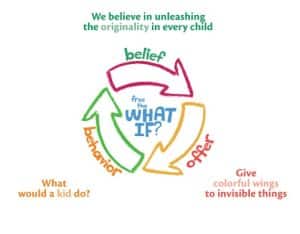Building a lasting relationship with your customers requires a lot of moving parts, the most important of which is your brand purpose. Consumers are increasingly aligning their loyalty with brands that stand for something meaningful. You have seen it in the marketing campaigns of top brands like Nike, Apple, The North Face, Facebook, Snapchat (Snapchat’s superbowl ad was all about the company’s brand purpose). They all have altruistic messaging and focus their strategies on doing good. The concept of brand purpose has never been more widespread and critical than it is now. Beyond mere profit margins and product features, today’s brands are expected to embody a purpose that resonates deeply with their audience—especially in the discerning eyes of Gen Z and Gen Alpha. But what exactly is a “brand purpose,” and why does it hold such sway in the modern marketplace?
Brand purpose goes above and beyond the basic act of selling products or services; it’s about embodying a deeper, more meaningful mission that resonates with both the internal culture of a company and its external audience. It’s not merely about what a company does, but why it does what it does—the emotional and societal impact it aims to make beyond financial success.
You don’t want to tell a customer that you make shoes so that you can pad your pockets with more cash, you want to tell customers that you encourage them to be athletes in their everyday lives. You sell a feeling and a reward, the shoes just happen to help them in that journey.
Why Brand Purpose Matters in 2024
As time goes on, brand purpose has only become more important. Our digital world is becoming filled with rapid technological advancements and shifting consumer behaviors. Brands are finding that having a compelling, purpose-driven narrative is key to capturing and retaining the attention of their audience. But why is brand purpose increasingly becoming a cornerstone for successful brands?
First and most importantly, brand purpose aligns a company’s values with those of its customers. This alignment is not just a moral victory; it’s a strategic advantage. According to a Porter Novelli survey, a staggering 66% of consumers are willing to switch from a product they regularly buy to a new product from a purpose-driven company.
This figure jumps to an astonishing 91% among Millennials and given the trends, you can infer that Gen Z and Gen Alpha’s preferences skew strongly towards brands with a clear and compelling purpose.
Take a look at TikTok and Instagram, the content that wins in those environments is real, unedited, authentic media. In a society that has become obsessed with perfection and minimalism, younger generations are seeking a more authentic and purposeful experience.
Brand purpose is not just about attracting customers; it’s about building loyalty. The Sustainable Brands and Harris poll highlights that 80% of individuals are loyal to brands that help them live a “good life,” characterized by balance, simplicity, meaningful connections, and personal achievement. This loyalty translates into powerful brand advocacy, with the Cone Porter Novelli survey finding that 78% of consumers would tell others to buy from a purpose-driven company, and 73% would defend such a brand if it were negatively discussed.
“A clear purpose helps a brand stand out, not just through what it sells, but through the story it tells and the values it embodies.”

Brand purpose is about more than just selling products or services; it’s about building a meaningful connection with consumers that extends beyond the transactional. It’s about contributing positively to the world and aligning with the values and aspirations of your audience. As we navigate through 2024 and beyond, the brands that understand and leverage the power of their purpose are the ones that will thrive, creating lasting impacts on their communities and securing their place in the hearts and minds of consumers.
Discovering Your Brand’s Purpose
Discovering your brand’s purpose isn’t about fabricating a catchy tagline or slogan; it’s a process of uncovering the core mission that drives your company. It’s not something that an agency can simply conjure up for you, but rather a fundamental truth that needs to be discovered from within. So, how do you uncover your brand’s purpose?
Clarification
- The key to authenticity lies in uncovering the essence of what makes your brand unique.
- Your brand’s purpose should resonate with your team and customers on a deeper level.
- Brand purpose is not something that should be “come up with” in a brainstorming session. Instead, it’s about “discovering” the mission that naturally aligns with your brand’s values and aspirations.

Framework and Examples
- A practical approach to finding your brand purpose is to analyze the missions of well-known purpose-driven companies. For instance, Crayola’s purpose is to “unleash the originality in every child,” and Dove aims “to help women everywhere develop a positive relationship with the way they look.” Neither of these purpose statements mentions the company’s products directly. Instead, they Focus on the emotional outcomes their brands seek to achieve.
How to Uncover Your Brand’s Purpose
- Focus on what ignites passion within your team and aligns with your audience’s needs.
- Avoid narrow focus on financial goals or product features in favor of a purpose that’s high-level and emotional.
- Capture the bigger picture of what your brand offers to the world.
A practical exercise is to engage in conversations with your customers, employees, and leadership to uncover what truly drives them.
Additionally, structuring your purpose statement around a verb can help clarify the intended impact. Verbs like “inspire,” “help,” and “unleash” make a strong foundation for a purpose statement that conveys action and impact. For example, Big Red Jelly’s purpose is “To inspire creativity and growth.”
Finding Your Brand’s Purpose With Big Red Jelly
We at Big Red Jelly have implemented brand purpose discovery into every one of our client projects. We believe that without a purpose driving the brand, it lacks the emotional connection that resonates deeply with many customers. Working with us includes taking the important steps needed to build a lasting relationship with your customers.
Embrace the challenge of uncovering your brand’s purpose by working with Big Red Jelly, and watch as it transforms your brand into a beacon of inspiration, loyalty, and success.







